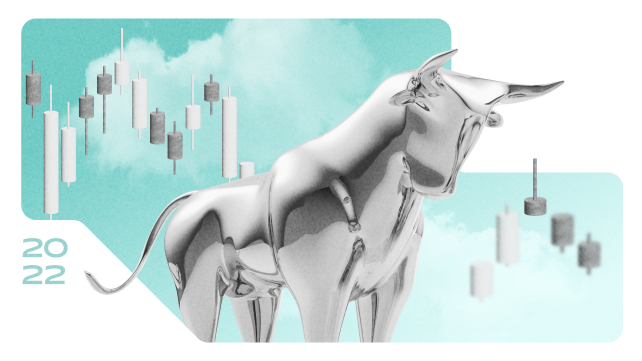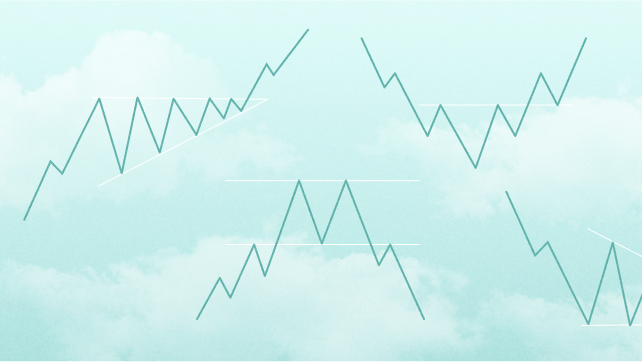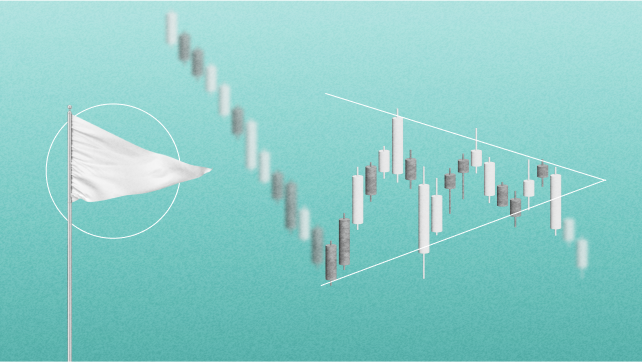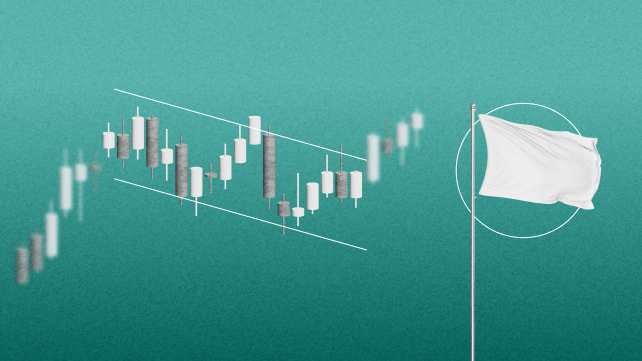A Beginner’s Guide to the Best Day Trading Patterns

In simple words, patterns in day trading are the shapes of the price chart. These shapes allow traders to determine the potential direction of price movement.
To prevent a novice trader from getting confused by the variety of shapes, in this article, we will break down the basic patterns for day trading and teach you how to use them in trading.
Trading patterns for beginners
Trading patterns are essential because charts tend to produce frequent signals that cut through the noise of price action. Recognizing and interpreting these patterns can help you build a clear picture and mark trade signals to predict future price movement.
Different patterns serve different purposes, and the first thing you need to learn is how to distinguish them.

When using technical analysis for trading, the main thing you should pay attention to is one of the most researched tools — chart patterns. There are several types of chart patterns commonly used for trading. Some of the most popular ones are:
- Double top;
- Double bottom;
- Head and shoulders;
- Inverse head and shoulders;
- Triangle (descending, ascending, or symmetrical);
- Channel (horizontal, descending, or ascending);
- Bullish or bearish trend continuation;
- Falling or rising wedge.
In addition to chart patterns, traders might use Japanese candlestick patterns. We will consider the most popular ones for day trading in more detail further in this article.
What is a chart pattern?
In any trading terminal, you can use different ways to analyze the market with the help of technical analysis. It includes sustainable techniques and tools that allow you to analyze the current situation on the chart.
A chart is a set of prices superimposed, most often, on a time interval. As a rule, the ordinate of the chart represents the price scale and the abscissa the time scale. The asset prices are plotted from left to right so that the right side of the chart shows the most recent data.
Charts allow you to quickly get market data, such as the correlation of buyers and sellers, the prevailing trend, and the price value over time, to carry out technical analysis based on this information and predict what the price of an asset will be.
Traders usually implement different tools to the chart for better and quicker analysis. These tools include applying horizontal lines (support and resistance) and trend lines. Trend lines are the lines on the chart that determine the direction of the price. If the price forms higher highs and higher lows, it is an uptrend. Vice versa, if the price forms lower highs and lower lows, it is a downtrend.
Therefore, a chart pattern is a combination of support and resistance lines that help to determine whether the trend will reverse or continue.
For trading within a day, traders use smaller timeframes to see short-term movements of the price.
Why are chart patterns important?
A fusion of statistics, mathematics, and sociology often allows us to predict stock price movements. The fundamental rule of this type of analytics is that history repeats itself. When chart patterns appear, a trader understands that the price is very likely to behave the same way it did in most cases when this pattern appeared on the chart before.
Investors often use patterns in graphical analysis of a company's stock price during the current period in addition to fundamental analysis. If an issuer's business is booming, outperforming its competitors, and the market is promising, patterns can be used to select a specific entry point. It is most convenient to overlay the patterns on a candlestick chart, so it is easier to track price fluctuations.
Day trading patterns are based on empirical evidence of traders. Research papers mostly deny the long-term effectiveness of chart patterns as the expected value of these patterns is less than 0.5. However, trading with chart patterns combined with a deep understanding of price movements may be profitable.
Types of chart patterns
There are many chart trading patterns, sometimes with fancy names, such as a zigzag pattern. The two continuation patterns used most by day traders are the flag and the pennant. The pennant pattern is similar to a symmetrical triangle; the flag pattern is similar to a rectangle. These are powerful common trends. Once a trader grasps the understanding of these patterns, it may lead them to better results.
Pennant

This pattern is often referred to as a triangle. The upper boundary of the pennant is directed downward, and the lower boundary is directed upward. The price range fades with each change of direction, drawing a narrowing corridor. The pattern can often be found after strong impulse movements of the asset in the direction of the main trend.
The signal to enter the trade appears after the breakdown of the pennant boundary in the direction of the main trend. For a downtrend, the picture is mirrored.
Flag

A continuation pattern, which is directed against the main trend. It often appears after a strong move in the chart and shows that the bears have mistaken a small correction for a reversal, and some sellers are opening positions. At some point, the buyers fight again, the channel boundary is broken, and the trend continues in the old direction. To enter the trade, the fact of the breakdown of the borders of the flag in the direction of the main trend is used.
Candlestick patterns
Japanese candlestick is the oldest method of technical analysis known to the world. The candlestick chart is one of the most popular charts, allowing traders to quickly and easily interpret price information.
Over time, individual candlesticks form patterns that traders can use to recognize major support and resistance levels. There are many candlestick patterns that indicate opportunities in the market. Some indicate the balance between buying and selling pressure, while others identify continuation patterns or market indecision.
A series of candlesticks on the chart helps traders more accurately determine the nature of price movement in the market and, consequently, ease the decision-making.
In order to understand this, let's look at some basic candlestick patterns, which are useful for day trading.
Shooting star candlestick

A shooting star pattern appears in a rising market and heralds the imminent arrival of a downward trend. Graphically, the shooting star is a short candle with a missing bottom shadow and a very long top shadow. The color of the candle is mainly not important, but in general, the pattern with a black (red) candle will be stronger.
Hammer candlestick

The hammer candlestick, on the contrary, signals a change from a downtrend to an uptrend. It is a small candle with a long lower shadow. The upper shadow is either absent or very small. When trading on short timeframes, the white (green) hammer will be stronger than the black (red) one. But in large timeframes, it does not matter much.
Bullish and bearish engulfing

Bullish and bearish engulfing patterns are some of the best candlestick patterns for day trading. Bullish engulfing is formed when the body of a white (green) candle completely engulfs the previous black (red) candle, which signals a strong buying impulse.
Similar to bullish engulfing, a bearish engulfing pattern is formed when a bearish candle consumes the preceding bullish candle, which signals a strong selling impulse.
In conclusion
Patterns in day trading can produce reliable trading signals, the correct identification of which will allow you to understand the intricacies of the financial markets. The experience of many successful traders confirms their effectiveness.
Despite their value, charts are only one of the many tools available to a trader. It is also important to consider news, events, research, and market analyses to make informed trading decisions. Regardless of the situation, you should never invest more than you can afford to lose.